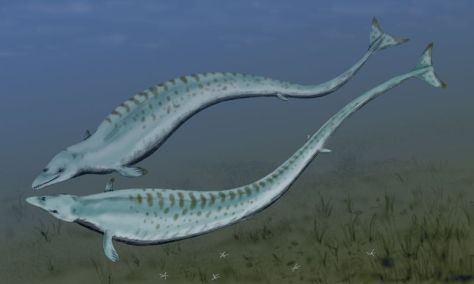Cetaceans have always called attention to people, either for their spectacular lives, their intelligence or their imposing size. But, do you know which the origin of dolphins and whales is? Do you know how they have evolved? Here, you can discover the answers!
TERRESTRIAL ORIGIN
Cetaceans originated in the ancient Tethys ocean, 50 million years ago, from terrestrial mammals that were adapting to the aquatic environment. They have evolved so that they are the dominant group of marine mammals for their species and habitats diversity and their wide distribution in the planet.

FROM EARTH TO SEA: THE EVOLUTION OF FIRST CETACEANS
Archaeocetes are the group of primitive cetaceans that lived during the Eocene (34-55 million years ago, mya), which were developing the features to live in the aquatic environment. Among archaeocetes, we find the organism that originated the two nowadays groups of cetaceans, the toothed whales and the baleen whales. We may find 5 families in this group: the Pakicetidae, Protocetidae, Ambulocetidae, Remingtonocetidae and Basilosauridae.
THE PAKICETIDAE
The Pakicetidae lived 50 mya in India and Pakistan, which had an appearance similar to wolf. They presented the nostrils close to the forehead and the eyes in a dorsal position, like crocodiles. The main feature to be classified as cetaceans is the structure of ears because they are adapted to an underwater hearing. In addition, they have dense bones to walk under the water. Pakicetidae were mainly terrestrial or freshwater animals. The most known animal is Pakicetus.

THE AMBULOCETIDAE
The next archaeocetes were the Ambulocetidae, also from India and Pakistan, present in the middle-Eocene (41-50 mya). They were similar to crocodiles in some features, with short fins and a powerful body and tail. They had a big head, with the eyes in a dorsal and laterally position. Their lower limbs were adapted to swim and they swam by ventrally rippling the body, like the nowadays whales.

THE REMINGTONOCETIDAE
The Remingtonocetidae were found in India and Pakistan, about 43-46 mya. Despite the archaeocetes had big snouts, in this group were specially big. It is thought that their size was between Pakicetidae and Ambulocetidae. The nostrils were placed close to the forehead, they had small eyes and the inner ear were more adapted to underwater life.

THE PROTOCETIDAE
The Protocetidae lived in the middle-Eocene and were found in India, Pakistan, Africa, Europe and North America. Probably, they lived in warm seas close to tropics. They had a long snout, big eyes and the position of nostrils allowed them to breathing without leaving the head of the water, like present cetaceans. There are so many genus, but the one that give the name to the group is Protocetus.

THE BASILOSAURIDAE
The last group are the Basilosauridae, which existed during the middle and last Eocene. Species could be between 4 and 18 m long. It’s a paraphyletic group, it is that all the descendents of the common ancestor are not included in the group. Their hind limbs were very reduced and their appearance were similar to the current cetaceans. The group includes, among other genera, Basilosaurus and Saghacetus .

REFEREES
- Berger WH. 2007. Cenozoic cooling, Antarctic nutrient pump, and the evolution of whales. Deep Sea Res. II 54, pp. 2399-2421.
- Berta A, Sumich J & Kovacs KM. 2011. Marine mammals. Evolutionary Biology. 2ª edició. Califòrnia: Academic Press
- Fordyce RE. 2009. Cetacean Evolution. Dins Perrin W, Würsig B & Thewissen JGM (ed). Encyclopedia of Marine Mammals. 2ª edició. Canadà: Academic Press. pp. 201-207
- Fordyce RE. 2003. Cetacea evolution and Eocene-Oligocene oceans revisited. Dins Prothero DR, Ivany LC & Nesbitt E (ed). Secondary Adaptation of Tetrapods to Life in Water. New York: Columbia University Press. pp. 154-170
- Gray NM, Kainec K, Madar S, Tomko L & Wolfe S. 2006. Sink or swim? Bone density as a mechanism for bouyancy control in early cetaceans. Anat. Rec.: Adv. Integr. Anat. Evol. Biol. 290. pp. 638-653
- Gingerich PD, Smith BH i Simons EL. 1990. Hind limbs of Eocene Basilosaurus: Evidence of feet in whales. Science 249. pp. 154-157
- Gringerich PD. 2005. Cetacea. Dins Rose KD & Archibald JD (ed). Placental Mammals: Origin, Timing, and Relationships of the Major Extant Clades. Baltimore: Johns Hopkings University Press. pp. 234-252
- Jaramillo Legorreta AM, Rojas Bracho L & Gerrodette T. 1999. A new abundance estimate for vaquitas: first step for recovery. Mar. Mamm. Sci 15 (4): 957-973
- Lindberg DR & Pyenson ND. 2007. Things that go bump in the night: Evolutionary between cephalopods and cetaceans in the Tertiary. Lethaia 40. pp. 335-343
- Miralles L, Lens S, Rodríguez-Folgar A, Carrillo M, Martín V, et al. (2013) Interspecific Introgression in Cetaceans: DNA Markers Reveal Post-F1 Status of a Pilot Whale. PLoS ONE 8(8): e69511. doi: 10.1371/journal.pone.0069511
- Thewissen JGM. 2009. Cetacean Evolution. Dins Perrin W, Würsig B & Thewissen JGM (ed). Encyclopedia of Marine Mammals. 2ª edició. Canadà: Academic Press. pp. 46-48
- Uhen MD. 2009. Basilosaurids. Dins Perrin W, Würsig B & Thewissen JGM (ed). Encyclopedia of Marine Mammals. 2ª edició. Canadà: Academic Press. pp. 91-94
- Uhen MD i Gingerich PD. 2001. New genus of dorudontine archaeocete (Cetacea) from the middle-to-late Eocene of South Carolina. Mar. Mamm. Sci. 17 (1). pp. 1-34
- Williams EM. 1998. Synopsis of the earliest cetaceans: Pakicetidae, Ambulocetidae, Remingtonocetidae and Protocetidae. Dins Thewissen JGM (ed). The Emergence of Whales, Evolutionary Patterns in the Origin of Cetacea. New York: Plenum Press. pp. 1-28


